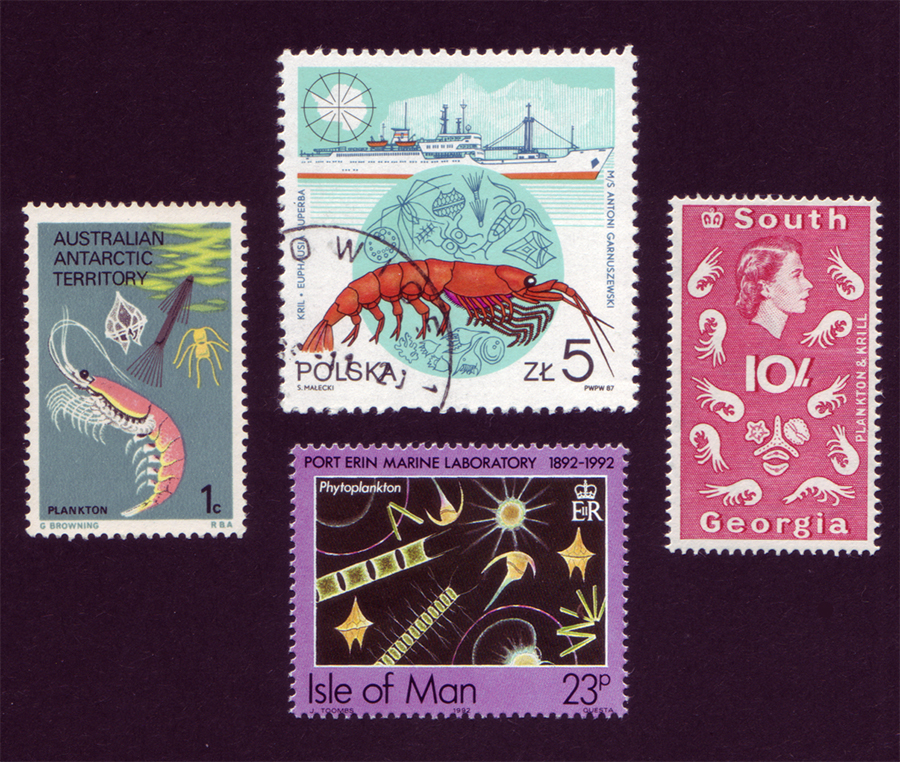
|
Micscape Lite article - contributors sharing their other interests. A series illustrating a selection of 'nasties' from Nature's chemistry set - by David Walker, UK |
As shared in earlier Lite articles I enjoy making physical models of molecules in the news, those with intrinsic beauty like DNA / carbon nanotubes / fullerenes or with a sociological interest like absinthe.
The challenge of building more complex relatively low molecular weight molecules (in contrast to e.g. proteins) are of particular interest especially Nature's 'nasties'—the many poisons in both animals and plants that if ingested will give humans a rather bad day—if in fact they live to see the next! I've already shared an article that illustrates strychnine, two more are shared below. Mother Nature has evolved a very impressive chemistry set and many of these molecules defy the most up to date techniques of modern organic chemistry to synthesise with either the same elegance or if at all for some molecules.
As remarked in previous articles, many molecules can be downloaded in seconds from databases and viewed as both 2D and 3D models from all angles. But by building a physical model you can really get to know a molecule and the strains in rings or preferred conformations are tactile during the build. The models are complemented by philately items on the same theme.
Dinoflagellates These single celled organisms are one of the most widespread planktonic forms especially in a marine environment. They are depicted on some stamps where a mix of marine plankton is featured, examples owned are shown below.

With a work background in the petrochemical industry, biochemistry never featured in college courses nor job requirements but endeavouring to learn some basics in retirement. One aspect that find fascinating is biochemical evolution. Some of the basic concepts of biological organism evolution seem quite intuitive, so for example, a bird species on an isolated island has a beak best suited for the local food resources (Darwin's finch studies) or an insect has a morphology to match its surroundings to avoid predators, e.g. a stick insect. But find it hard to grasp many aspects of the driving forces of biochemical evolution.
This is illustrated by the two toxins shown below made by dinoflagellates and other organisms (or occurs by ingestion in other organisms). The toxins are noted amongst chemists to be the two most complex molecules made by an organism (currently known!) that are not macromolecules (e.g. proteins, polypeptides, carbohydrates, polysaccharides). What is the driving force for a single celled organism which presumably has to be very economical with its biochemistry, to synthesize such complex molecules? There are clearly repeating similar building blocks in the toxins shown but many organisms make poisons that are much simpler, so was the organism slowly tweaking the molecule over millennia to be even more potent to whatever it viewed as its predator or does it have a role in the cell and just accidental that its effect on humans for example is deadly in minute quantities?
Palytoxin My interest in this compound was first piqued by reading John Mann's fascinating book 'Murder, Magic and Medicine' (OUP, 1992). The author's note on its complexity for a non-macromolecule prompted a model to be built. It was only after reading the Wikipedia entry on palytoxin that found it was now the second most complex to maitotoxin, hence the second more challenging build below. (Some folk pass the time building 1000+ piece jigsaws, this retired very rusty chemist builds models!) The Wikipedia entry for palytoxin gives a good account of its discovery, occurrence and isolation. Wikipedia notes that this molecule has now been successfully synthesized in 1994.
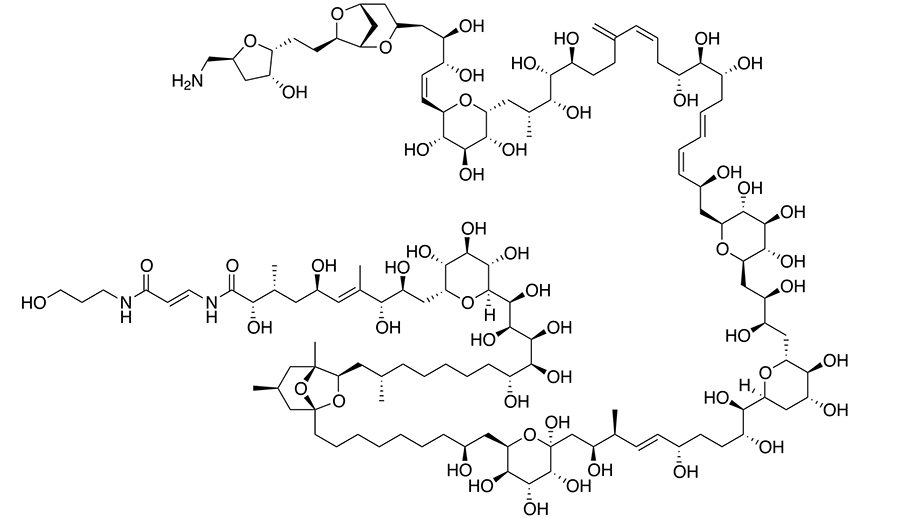
Skeletal formula sourced from the Wikipedia Palytoxin entry. C129H223N3O54
Credited to Charlesy - Own work. Public domain.
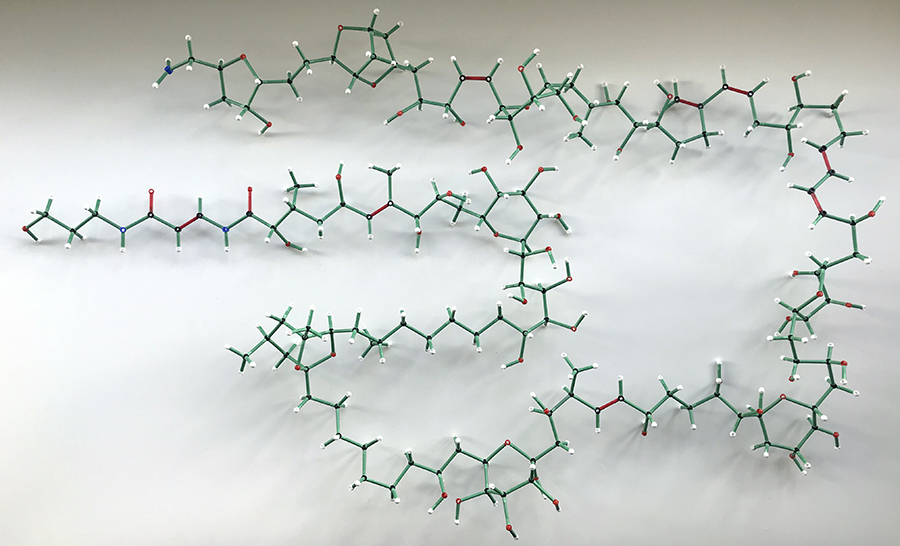
Palytoxin made using the Minit kits by Cochranes of Oxford.
Maitotoxin This molecule holds a particular fascination amongst chemists as it holds two world records as noted in J. Chandrasekhar's very accessible article 'Molecule of the Month. Maitotoxin - Holder of Two World Records'. Not only is it currently the most complex biomolecule known (with exceptions note above) but it is also the most deadliest. The LD50 dose is minute, 50 ng/kg in mice, no not a misprint that is nanograms, not milligrams! The Wikipedia entry for maitotoxin gives a good account of its discovery, occurrence and isolation. Also see 3Dchem.com 'Molecule of the Month for May 2020'. Due credit to the author Karl Harrison who also shows the only accurate 3D representation of the molecule generated in software that have found to date (see below).
This molecule remains a challenge for organic chemists to synthesize. Nicolau and Aversa in their 2011 paper 'Maitotoxin: An Inspiration for Synthesis' describes and illustrates their work to date. Their Figure 6 in the paper illustrates a possible mechanism reported by other workers (Murata and Yasumoto) for the molecule's toxicity. With both water and fat loving parts of the molecule it may span a cell membrane causing chaos with biochemical pathways.
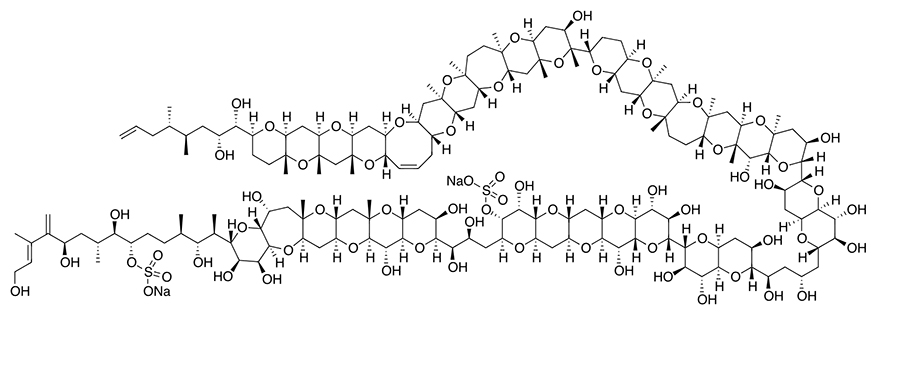
Skeletal formula sourced from the Wikipedia Maitotoxin entry. C164H256O68S2Na2
Credited to Charlesy - Own work, CC0, https://commons.wikimedia.org/w/index.php?curid=62221075, public domain.

The Cochranes of Oxford Minit kit is best suited to make complex molecules to keep the size manageable (but still 110 cm wide). It required five student kits to make. The skeletal formula used was that published in the paper by Nicolau and Aversa as primary source. Some secondary sources e.g. the Wikipedia example above differ slightly in stereochemical aspects. (The physical model matches the paper's author skeletal model but a mirror along the x axis of the public domain Wikipedia skeletal model).
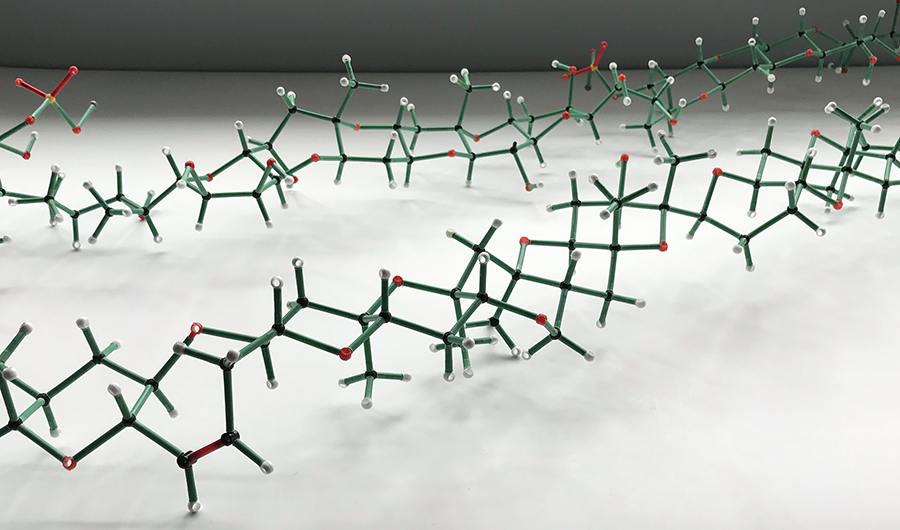
Detail of maitotoxin to show the multiple cyclic ethers (R-O-R'). When building a C5 or C6 ring of tetrahedral carbons the builder feels that it cannot be planar and the ring adopts one of two conformers. As remarked in a review article of model kits some software will present incorrectly such rings to be planar unless dive into menus to force energy minimisation. A potential trap for the unwary student.
The pros and cons of representing complex molecules in software
The ball and stick model above is my preference for learning and illustrating the internal structure of a molecule but does not of course bear any resemblance to the actual molecule's shape in space. The Molymod model system in space filling mode does allow a much representation but does not illustrate well the internal structure. Wikipedia has a valuable page on maitotoxin and due credit to the contributor Ben Mills who built
in software the space filling model below showing more accurately how
the molecule looks.
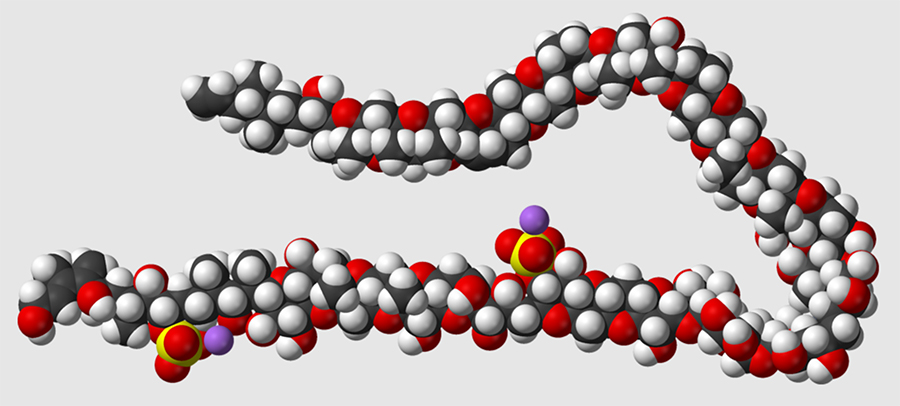
Space filling model of maitotoxin from the Wikipedia entry. Credited to Ben Mills, own work, public domain.
There is a wide variety molecular model freeware that allow molecules to be downloaded from a database to be presented as both a skeletal structure and the 3D interpretation by the software. The skeletal forms are correct but the 3D representation can often be nonsensical for reasons not entirely clear to me as not very familiar with such software's method of energy minimisation to
present the structure correctly.
I find the web page software MolView useful and below is illustrated its interpretation of the molecule downloaded from a database in 3D, it is shown completely flat!?
Wikipedia offers a 3D image of some molecules like maitotoxin and these are misrepresented in the same way in the widely used software JSMol a web page variant of JMol. As noted above Karl Harrison in his article shows it correctly, interestingly also with JSMol as used by Wikipedia so the source data clearly needs to be correct but unfamiliar with the software.
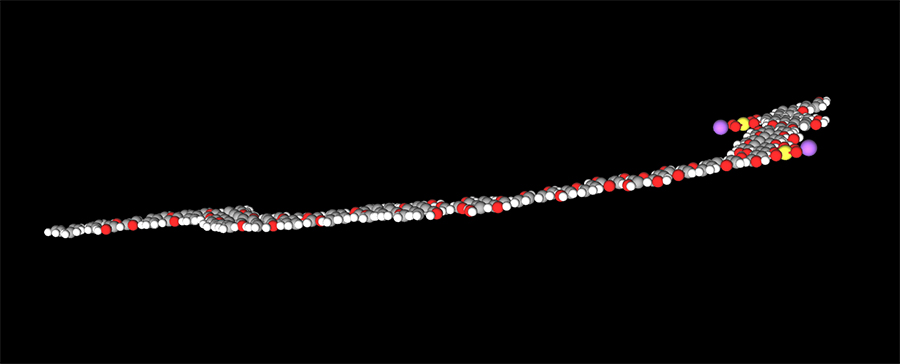
The web page software MolView which find very valuable for accessing skeletal formula from databases also shows the 3D structure of maitotoxin incorrectly as planar.
Comments to the author David Walker are welcomed.
Published in the November 2022 edition of Micscape.
Please report any Web problems or offer general comments to the Micscape Editor .
Micscape is the on-line monthly magazine of the Microscopy UK web site at Microscopy-UK
© Onview.net Ltd, Microscopy-UK, and all contributors 1995
onwards. All rights reserved.
Main site is
at www.microscopy-uk.org.uk
with full mirror
at www.microscopy-uk.net
.